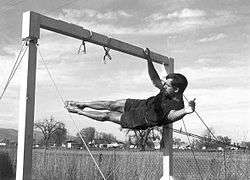Front lever
The front lever is a gymnastic and calisthenic move - a static hold normally performed on the still rings or the pull-up bar. A front lever is performed by lowering from an inverted hang until the body is completely horizontal and straight with the front of the body facing upwards. An accomplished gymnast may also pull directly into the horizontal position from a dead hang. Front levers require a high degree of back and core strength.
The move is rated A in the gymnastic code of points, a scale from A to F, with F being the most difficult. In the 1960s the move was rated B, when the levels of difficulty were A, B, and C. Evidently the athlete's body length is a factor in point scoring as world class gymnasts are shorter now than during the mid 20th century: for example the top American gymnast in 1956 was John Beckner - 6' 1",[1] whereas the 2004 Olympic champion American gymnast, Paul Hamm, is 5' 4".
Variations
There are many variations for the Front Lever. The easiest is the tuck front lever, then the advanced tuck variation (where the back is kept flat), then the single leg front lever, straddle front lever, and finally on to the full front lever. At any stage of learning the skill the gymnast may perform pull-ups in the front lever position of their choice.

One arm front lever
A front lever held with just one arm. The body is often turned sideways in this variation
Exercises based on the front lever
Front lever pullups
The body is kept horizontal while the gymnast performs a pullup.
Ice cream makers
In this variation the performer leans forward from the lever position, bringing the legs down and arms up until he/she reaches the top of a regular pullup. From here they lean back again, straightening the arms and returning to the front lever
References
- Modern Gymnast, December 1956, Page 12